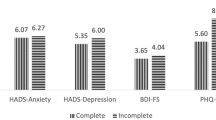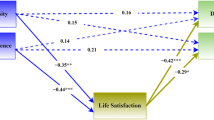Abstract
Study design:
Comparison of two self-report instruments with a structured diagnostic interview.
Objective:
To investigate the properties of the Depression Anxiety Stress Scales-21 (DASS-21) in patients with spinal cord injuries.
Setting:
South Australian Spinal Cord Injuries Service, Hampstead Rehabilitation Centre, Northfield, South Australia.
Methods:
Forty paraplegic or tetraplegic patients participated. Two self-report measures, DASS-21 and Brief Symptom Inventory (BSI), assessed Depression, Anxiety and Stress. These measures were compared with each other and with diagnoses based on the Mini International Neuropsychiatric Interview.
Results:
Mean scores on both self-report measures were below clinical threshold levels. Prevalence rates of anxiety and depression were higher on DASS-21 than on BSI. DASS-21 was as sensitive as BSI, but had lower specificity to detect anxiety and depression.
Conclusion:
DASS-21 is a promising screening measure for patients with spinal cord injury in a rehabilitation setting. It has greater sensitivity for identifying those with possible anxiety disorders than it does for those with depressive disorders.
Similar content being viewed by others
Log in or create a free account to read this content
Gain free access to this article, as well as selected content from this journal and more on nature.com
or
References
Overholser JC, Schubert DSP . Depression in patients with spinal cord injuries: a synthesis of cognitive and somatic processes. Curr Psychol 1993; 12: 172–183.
Elliot TR, Frank RG . Depression following spinal cord injury. Arch Phys Med Rehabil 1996; 77: 816–823.
Vahle VJ, Andresen EM, Hagglund KJ . Depression measures in outcomes research. Arch Phys Med Rehabil 2000; 81 (Suppl 2): S53–S62.
Radnitz CL, Bockian N, Moran A . Assessment of psychopathology and personality in people with physical disabilities. In: Frank RG, Elliot TR (eds). Handbook of Rehabilitation Psychology. American Psychological Association: Washington, DC, 2000, pp 287–309.
Craig AR, Hancock KM, Dickson HG . A longitudinal investigation into anxiety and depression over the first two years of spinal cord injury. Paraplegia 1994; 32: 675–679.
Scivoletto G, Petrelli A, Di Lucente L, Castellano V . Psychological investigation of spinal cord injury patients. Spinal Cord 1997; 35: 516–520.
Wilder EI . Wheeling and Dealing: living with Spinal Cord Injury. Vanderbilt University Press, Nashville, 2006, pp 43–50.
Overholser JC, Schubert DSP, Foliart R, Frost F . Assessment of emotional distress following a spinal cord injury. Rehabil Psychol 1993; 38: 187–198.
Frank RG, Chaney JM, Clay DL, Shutty MS, Beck NC, Kay DR et al. Dysphoria: a major symptom factor in persons with disability or chronic illness. Psychiatry Res 1992; 43: 231–241.
Jacob K, Zachariah K, Bhattacharji S . Depression in individuals with spinal cord injury: methodological issues. Paraplegia 1995; 33: 377–380.
Lovibond SH, Lovibond PF . Manual for the Depression Anxiety Stress Scales, 2nd edn. Psychology Foundation of Australia: Sydney, 1995.
Lovibond PF, Lovibond SH . The structure of negative emotional states: comparison of the Depression Anxiety Stress Scales (DASS) with the beck depression and anxiety inventories. Behav Res Ther 1995; 33: 335–342.
Derogatis L, Spencer P . The Brief Symptom Inventory (BSI): Administration, Scoring and Procedures Manual. Johns Hopkins University School of Medicine: Baltimore, 1982.
Sheehan DV, Lecrubier Y, Sheehan KH, Amorim P, Janavs J, Weiller E et al. The Mini-International Neuropsychiatric Interview (MINI): the development and validation of a structured diagnostic psychiatric interview. J Clin Psychiatry 1998; 59 (Suppl 20): 22–23.
Antony MM, Bieling PJ, Cox BJ, Enns MW, Swinson RP (1998) Psychometric properties of the 42-item and 21-item versions of the Depression Anxiety Stress Scales in clinical groups and a community sample. Psychol Assess 1998; 10: 176–181.
Heinrich RB, Tate DG, Buckelew SP . Brief symptom inventory norms for spinal cord injury. Rehabil Psychol 1994; 39: 49–56.
Tate DG, Forchheimer M, Maynard F, Davidoff G, Dijkers M . Comparing two measures of depression in spinal cord injury. Rehabil Psychol 1993; 38: 53–61.
American Psychiatric Association. Diagnostic and Statistical Manual of Mental Disorders: DSM-IV, 4th edn. American Psychiatric Association: Washington, DC, 1994.
World Health Organization. The ICD-10 Classification of Mental and Behavioural Disorders: Diagnostic Criteria for Research. World Health Organization: Geneva, 1993.
Brown TA, Chorpita BF, Korotitsch W, Barlow DH . Psychometric properties of the Depression Anxiety Stress Scales (DASS) in clinical samples. Behav Res Ther 1997; 35: 79–89.
Acknowledgements
We acknowledge the patients of the Hampstead Rehabilitation Centre for their participation and the staff of the centre for their assistance.
Author information
Authors and Affiliations
Corresponding author
Rights and permissions
About this article
Cite this article
Mitchell, M., Burns, N. & Dorstyn, D. Screening for depression and anxiety in spinal cord injury with DASS-21. Spinal Cord 46, 547–551 (2008). https://doi.org/10.1038/sj.sc.3102154
Received:
Revised:
Accepted:
Published:
Issue date:
DOI: https://doi.org/10.1038/sj.sc.3102154
Keywords
This article is cited by
-
Impact of the COVID-19 pandemic on the quality of life and accessing rehabilitation services among patients with spinal cord injury and their fear of COVID-19
Journal of Orthopaedic Surgery and Research (2023)
-
Clinical and demographic predictors of symptoms of depression and anxiety in patients with spinal cord injury
Spinal Cord (2022)
-
The short-term effects of head-mounted virtual-reality on neuropathic pain intensity in people with spinal cord injury pain: a randomised cross-over pilot study
Spinal Cord (2021)
-
Prevalence and psychometric screening for the detection of major depressive disorder and post-traumatic stress disorder in adults injured in a motor vehicle crash who are engaged in compensation
BMC Psychology (2018)
-
Unintentional and intentional non-adherence to immunosuppressive medications in renal transplant recipients
International Journal of Clinical Pharmacy (2018)



